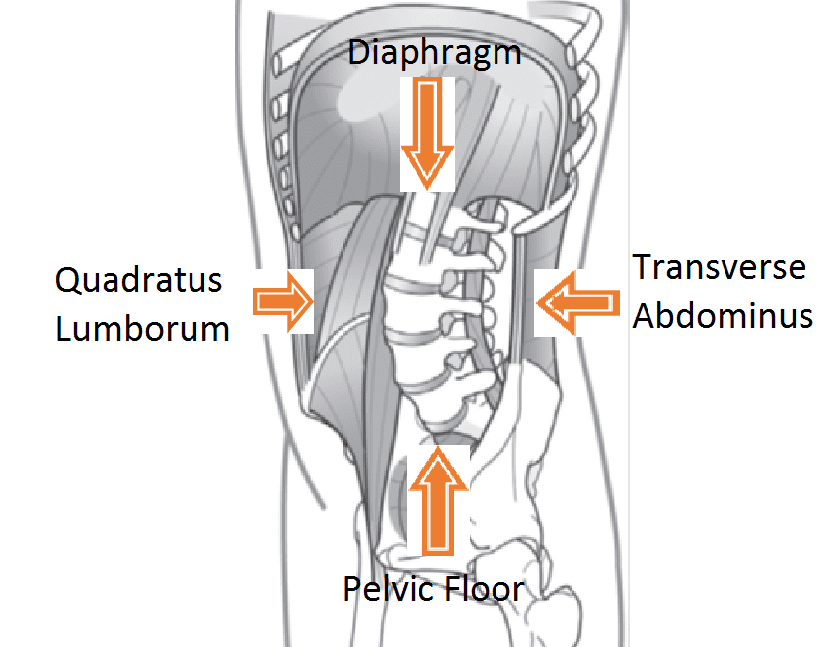Pelvic Floor Weakness Impacts More Than You Think
Difficulty controlling your bladder or leakage of urine upon exertion (laughing, coughing, sneezing, jumping) is something that women can experience due to a weak pelvic floor. However, the pelvic floor does more for your body than simply control your bladder. Pelvic floor dysfunction can lead to back pain, sacroiliac dysfunction, and even hip pain. If you have had low back pain or sacroiliac pain and have tried multiple therapies without relief; you may want to strengthen this often overlooked culprit.
The pelvic floor muscles attach from your pubic bone to your tail bone and act as a supportive sling for your bladder, uterus, and rectum. The pelvic floor becomes active when you exert a downward force on it by contracting your abdominals and diaphragm. Certain activities will increase the amount of force required from the pelvic floor. Major increases occur from coughing, sneezing, laughing, running, and jumping (5). I know what you are thinking, “How does this relate to my back pain?”
It’s all about “the core!”
When you think of a strong core, do six pack abs come to mind? Our core is made of a host of muscles (not just the ones responsible for the six pack); with the pelvic floor playing a major supportive role. The pelvic floor muscles are the base of the core. Our abdominals, low back muscles, hip muscles, diaphragm, and pelvic floor work together to stabilize the spine. The core stabilizes the spine through IAP or intra-abdominal pressure. This occurs when the diaphragm contracts down; causing the pelvic floor and transverse abdominus to lift up, creating a stable environment for the spine (3).

As shown by the orange arrows, the muscles of the core co-contract creating stability for the spine. If the pelvic floor is weak, the pressure created by the abdominals and diaphragm exits through the pelvic floor. Without a strong base, the integrity of the lumbar spine and SI joint is comprised and can lead to injury or dysfunction (3). Meaning, if you have frequent urine leakage, you may be at an increased risk for developing back pain.
Still not convinced the pelvic floor does more than just control your bladder? Weakness in the pelvic floor has been linked with arthritis in the hip joint. Multiple hip muscles attach into the pelvic floor to increase the tension of the pelvic floor. Weak hip muscles due to arthritis can therefore decrease tension in the pelvic floor and contribute to incontinence issues (4). One study found that 64% of women with symptoms of incontinence had improvement in their symptoms after a hip replacement (4).
How can we stop the leak?
Considering the variety of people who can experience pelvic floor dysfunction and its contribution to low back pain, it is important to learn how to properly strengthen the pelvic floor. This is where kegels come into play. The Kegel is an active contraction of the pelvic floor, and is more difficult to master than most realize. It is important to envision lifting the pelvic floor upward and not bearing down or over activating the abdominals. Isolating this type of contraction without over recruitment of other spinal stabilizers will be key for proper strengthening. Another area for error occurs with improper breathing. The kegel should be performed while exhaling. Inhalation during a pelvic floor contraction causes the diaphragm to push down; thus increasing pressure on the pelvic floor.
If you are like me, you are currently trying to perform a kegel and wondering “Is this right?” If you are struggling to contract the pelvic floor while simply sitting, imagine how hard it will be when you are walking, bending, or lifting? This is where a pelvic floor therapist can help. If you are unsure of how to properly perform a kegel exercise, while maintaining proper breathing, then it is best to retrain this muscle group under the care of a trained professional. Don’t let a weak pelvic floor impact your hips or your back!
References
- Gorina Y, Schappert S, Bercovitz A, et al. Prevalence of incontinence among older Americans. National Center for Health Statistics. Vital Health Stat 3(36). 2014.
- Herschorn, Sanders. Female Pelvic Floor Anatomy:The Pelvic Floor, Supporting Structures, and Pelvic Organs. Reviews in Urology. Volume 6 Suppl 5. 2004.
- Key, Josephine. The core’: Understanding it, and retraining its dysfunction. Journal of Bodywork & Movement Therapies. Volume 17. 2013. 541-559.
- Tamaki, T et al. Hip dysfunction-related urinary incontinence: A prospective analysis of 189 female patients undergoing total hip arthroplasty. International Journal of Urology. Volume 21. 2014. 729-731.
- Serati, M et al. Prospective study to assess risk factors for pelvic floor dysfunction after delivery. Acta Obsetricia et Gynecologica. 87. 2008. 313-318.
Want to feel and move your best?
Treatment is covered by insurance, no referral is needed to start, and with flexible virtual and in-clinic appointments available, you can find a time that works with your schedule.
Click the button below to get started.
